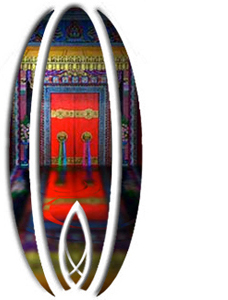Kabbalah
- At June 10, 2009
- By Betty
- In Mysticism, Religion
 0
0

Kabbalah literally means “receiving”, in the sense of a “received tradition”, and is sometimes transliterated as Cabala, Kabbala, Qabalah, or other permutations. Kabbalah esoterically interprets the Hebrew Bible (Tanakh) and classical Jewish texts (halakha and aggadah) and practices (mitzvot), as expressing a mystical doctrine concerning God’s simultaneous immanence and transcendence, an attempted resolution to the ancient paradox of how the ultimate Being “that which is not conceivable by thinking” (Isaac the Blind) nevertheless comes to be known and experienced by the created world.
Because of the interpretive liberties taken by kabbalistic thinkers, and the possible heresies to which they may easily lead, study of Kabbalah was traditionally restricted to a select few Rabbis and Torah scholars. As Joseph Albo puts it in his Sefer Ha-Ikkarim (II:28, 15th century, trans:Husik), “This is why the science treating these things is called Kabbalah (lit. tradition), because tradition must be followed in the study and the practice of it, else one is liable to commit an error and to worship as God some one other than the Lord.”
The term Kabbalah originally refers to Talmudic texts from the Gnostic era, among the Geonim (early medieval rabbis) and by Rishonim (later medieval rabbis) as a reference to the full body of the oral tradition of Jewish teaching, which was publicly available. Even the works of the Tanakh’s prophets were referred to as Kabbalah, before they were canonized as part of the written tradition. In this sense Kabbalah was used in referring to all of Judaism’s oral law. Over time, much of the oral law was recorded, but the esoteric teachings remained an oral tradition. Now, even though the esoteric teachings of the Torah are recorded, it is still known as Kabbalah.
Thus, this term became connected with doctrines of esoteric knowledge concerning God, the human being and the relationship between them. Ontology, cosmogony, and cosmology are the main components of this esoteric lore. The reasons for the commandments in the Torah and the ways by which God administers the existence of the universe are also a part of the Kabbalah.
According to most segments of Orthodox Jewry, this esoteric Kabbalah dates from Adam and is an integral part of the Jewish tradition. They believe that this esoteric knowledge has come down from a remote past as a revelation to elect Tzadikim (“righteous men”), and for the most part, was preserved only by a privileged few. According to contemporary scholarship, the various schools of Jewish esotericism have arisen at different periods of Jewish history, each reflecting not only prior forms of Jewish esotericism but also the intellectual and culture milieu of that historical period. Questions of transmission, influence, and innovation vary and cannot be summarized with a simple doctrinaire claim.
According to adherents of Kabbalah, the origin of Kabbalah begins with secrets that God revealed to Adam. According to a rabbinic midrash[citation needed] God created the universe through the ten sefirot. When read by later generations of Kabbalists, the Torah’s description of the creation in the Book of Genesis reveals mysteries about the godhead itself, the true nature of Adam and Eve, the Garden of Eden, the Tree of Knowledge of Good and Evil and the Tree of Life, as well as the interaction of these supernal entities with the Serpent which leads to disaster when they eat the forbidden fruit, as recorded in Genesis 2.
The Bible provides ample additional material for mythic and mystical speculation. The prophet Ezekiel’s visions in particular attracted much mystical speculation, as did Isaiah’s Temple vision (Chapter 6). Jacob’s vision of the ladder to heaven is another text providing an example of a mystical experience. Moses’ experience with the Burning bush and his encounters with God on Mount Sinai, are all evidence of mystical events in the Tanakh, and form the origin of Jewish mystical beliefs.
The 72 names of God which are used in Jewish mysticism are derived from the Hebrew verses Moses spoke to part the Red Sea, allowing the Hebrews to escape their approaching enemies with the assistance of an angel. This is the greatest miracle of the Exodus of the Hebrews which led to receiving of the Ten Commandments and acceptance of the Torah at Mount Sinai creating the first Jewish nation approximately three hundred years before King Saul.
Some scholars have even proposed an Indian origin for this mystic system. They credit it to the Sage Kapila who founded the Indian system of Samkhya-Yoga.
Jewish forms of esotericism did, however, exist over 2,000 years ago. Ben Sira warns against it, saying: “You shall have no business with secret things” (Sirach iii. 22; compare Talmud Hagigah 13a; Midrash Genesis Rabbah viii.).
Apocalyptic literature belonging to the second and first pre-Christian centuries contained elements that carry over to later Kabbalah. According to Josephus such writings were in the possession of the Essenes, and were jealously guarded by them against disclosure, for which they claimed a hoary antiquity (see Philo, “De Vita Contemplativa,” iii., and Hippolytus, “Refutation of all Heresies,” ix. 27).
That books containing secret lore were kept hidden away by (or for) the “enlightened” is stated in IV Esdras xiv. 45-46, where Pseudo-Ezra is told to publish the twenty-four books of the canon openly that the worthy and the unworthy may alike read, but to keep the seventy other books hidden in order to “deliver them only to such as be wise” (compare Dan. xii. 10); for in them are the spring of understanding, the fountain of wisdom, and the stream of knowledge.
Instructive for the study of the development of Jewish mysticism is the Book of Jubilees written around the time of King John Hyrcanus. It refers to mysterious writings of Jared, Cain, and Noah, and presents Abraham as the renewer, and Levi as the permanent guardian, of these ancient writings. It offers a cosmogony based upon the twenty-two letters of the Hebrew alphabet, and connected with Jewish chronology and Messianology, while at the same time insisting upon the heptad (7) as the holy number rather than upon the decadic (10) system adopted by the later haggadists and the Sefer Yetzirah. The Pythagorean idea of the creative powers of numbers and letters was shared with Sefer Yetzirah and was known in the time of the Mishnah (before 200 CE).
Early elements of Jewish mysticism can be found in the non-Biblical texts of the Dead Sea Scrolls, such as the Song of the Sabbath Sacrifice. Some parts of the Talmud and the midrash also focus on the esoteric and mystical, particularly Chagigah 12b-14b. Many esoteric texts, among them Hekalot Rabbati, Sefer HaBahir, Torat Hakana, Sefer P’liyah, Midrash Otiyot d’Rabbi Akiva, the Bahir, and the Zohar claim to be from the talmudic era, though some of these works, most notably the Bahir and Zohar, are considered by modern scholars to clearly be medieval works pseudepigraphically ascribed to the ancient past. Traditional orthodoxy, however, does not agree to this. In the medieval era Jewish mysticism developed under the influence of the word-number esoteric text Sefer Yetzirah. Jewish sources attribute the book to the biblical patriarch Abraham, though the text itself offers no claim as to authorship. This book, and especially its embryonic concept of the “sefirot,” became the object of systematic study of several mystical brotherhoods which eventually came to be called baale ha-kabbalah (“possessors or masters of the Kabbalah”).
Kabbalah (Jewish mysticism) teaches that God is neither matter nor spirit. Rather God is the creator of both, but is himself neither. But if God is so different from his creation, how can there be any interaction between the Creator and the created? This question prompted Kabbalists to envision two aspects of God, (a) God himself, who in the end is unknowable, and (b) the revealed aspect of God that created the universe, preserves the universe, and interacts with mankind. Kabbalists speak of the first aspect of God as Ein Sof; this is translated as “the infinite”, “endless”, or “that which has no limits”. In this view, nothing can be said about this aspect of God. This aspect of God is impersonal. The second aspect of divine emanations, however, is at least partially accessible to human thought. Kabbalists believe that these two aspects are not contradictory but, through the mechanism of progressive emanation, complement one another. See Divine simplicity; Tzimtzum. The structure of these emanations have been characterized in various ways: Four “worlds” (Azilut, Yitzirah, Beriyah, and Asiyah), Sefirot, or Partzufim (“faces”). Later systems harmonize these models.
Some Kabbalistic scholars, such as Moses ben Jacob Cordovero, believe that all things are linked to God through these emanations, making us all part of one great chain of being. Others, such as Schneur Zalman of Liadi (founder of Lubavitch (Chabad) Hasidism), hold that God is all that really exists; all else is completely undifferentiated from God’s perspective. If improperly explained, such views can be interpreted as panentheism or pantheism. In truth, according to this philosophy, God’s existence is higher than anything that this world can express, yet He includes all things of this world down to the finest detail in such a perfect unity that His creation of the world effected no change in Him whatsoever. This paradox is dealt with at length in the Chabad Chassidic texts.

